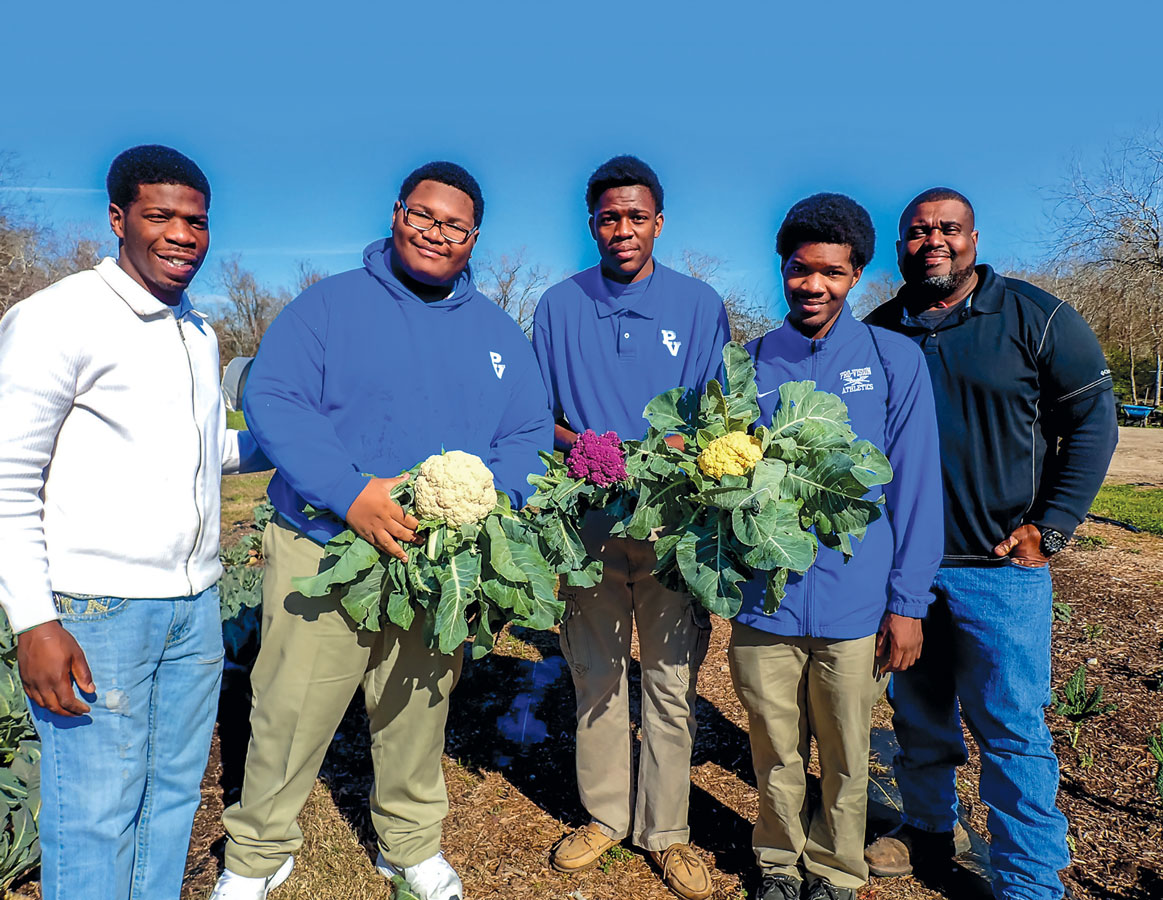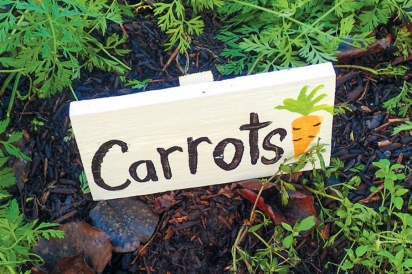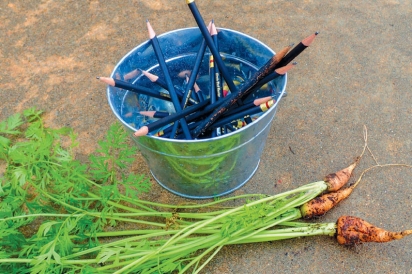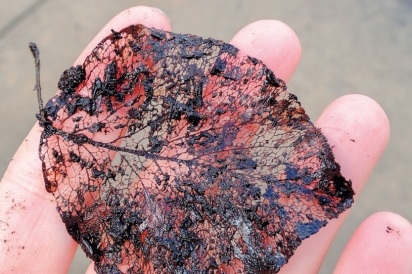Growing up Growing Food - Outdoor Classrooms Make a Difference
The Outdoor Classroom Offers Youth an Appreciation for Food and Community
Nearly an acre and a half of a school campus in Houston’s Sunnyside is dedicated to agriculture. From raised beds and row crops to aquaponics greenhouses, students learn about farming methods and growing food, as well as leadership, teamwork, perseverance and community in the unique Manhood Development mentor program.
“We took a poll of our students and asked where does food come from,” says Coach Timothy Tate of Pro-Vision Academy about the Urban Farm, developed almost five years ago to educate the students about the origins of food. “Most of them assumed it came from the grocery store.” Currently, about 20 students are enrolled in the mentor program, learning about growing food from seed to harvest.
Coach Tate is a Certified Organic Vegetable Specialist and a voracious reader of gardening and farming books. He was raised with homegrown food inspiring his concern: “We want to help change this community and others like it from a food desert to sustainable food producers. We also want to be better stewards of the water.” The farm’s crops are cultivated without chemicals, with future plans to apply for organic certification. An irrigation canal surrounds three large fields, leading into a larger holding pond for the recapture of water runoff and rain with a goal of self-sufficiency.
One of the mentors in the program is Jeremy Peaches, himself an alumnus who came to Pro-Vision in the sixth grade. He recently graduated from Prairie View A&M with a bachelor’s degree in animal science. After working for the USDA and the Forest Service, Jeremy was offered a job as a mentor in the Urban Farm Program. He accepted, wanting to give back to the community that offered him the opportunity to achieve his dreams. Jeremy proudly envisions the mentor program as a model for teaching youth how to grow food.
On a sunny winter’s day, together with Coach Tate, Jeremy Peaches and three senior students in the program—Taylor, Chris and Daryl— we walk among the garden beds of brightly colored Swiss chard, mustard greens and kale. Unusual brassicas such as Romanesco broccoli and purple cauliflower grow as row crops. Adding to the farm’s acreage, six large greenhouses are under construction. Surrounding the property is an additional 21 acres of native brush and trees. The men are excited to elaborate on gardening, soil and giving back to the community.
“From the first day,” Taylor says, “Coach Tate showed us how to plant seeds, pick weeds and trim trees. He taught us how to take care of a garden.” Many of the program’s participants maintain the crops after school, on weekends and during the summer. Daryl adds, “We can come back between classes or whenever we have time.”
Taylor built a garden bed at home with his grandfather to practice what he learns on the farm. The school provides seeds, and now he is able to cook with homegrown vegetables. Chris tried growing strawberries at home with some success until “my little niece ate them all.” His favorite vegetable so far is “cauliflower—the cheddar variety.” All three agree that the daily hard work of tending crops from planting to watering helps develop an appreciation for the flavor of fresh-harvested vegetables.
Taylor is also the resident beekeeper. There are six top-bar hives on the farm. The original fruit tree orchard suffered from the overabundant rains and too little sunlight. Says Coach Tate, “Our failures will lead to future success.” According to both Coach Tate and Taylor, herbs helped to feed the bees, observing that Thai basil and mint are their favorite. Last year the hives yielded two gallons of honey. This spring new fruit trees will be planted and more hives added to increase farm production.
The original 10 beds have expanded into a full-scale production farm with 10% of the harvest offered to the surrounding neighborhood of Sunnyside, for single-parent homes and to the elderly across the road. Benjy’s and Local Foods discovered Pro-Vision at a farmers market in 2011. Currently both establishments purchase specialty greens and seasonal vegetables in addition to employing students from the program in their restaurants. The remaining vegetables from the Urban Farm Program are sold during school events, like football games and parent-teacher nights. The profits are reinvested for equipment, seeds, starter plants and other maintenance needs.
During the tour, we sample spicy Mizuna mustard leaves and sweet-tasting tender young collard greens and gab about recipes for radishes: thinly sliced with olive oil, salt and pepper, then roasted in the oven. Now everyone is eager to harvest the colorful Easter Egg radishes for dinner.
Across the road from the school is a horse stable where Jeremy now owns a horse named Mississippi Dreamer. The manure from the stables is utilized in the farm’s compost operation. Taylor eagerly recounts the recipe: “We get the horse manure and add banana peels and coffee grounds. Then we mix it up. Let it sit for a while. Once it’s ground up, we put it on the plants and it gets them energized.” Jeremy smiles and says, “That’s the teaching piece, the learning experience, as it all connects.”
Across town in Cypress at Sampson Elementary Stephanie Baker from Ready to Grow Gardens agrees that “giving students the opportunity to notice and discover rather than pointing out is where the real learning happens.” For 14 years Baker has been building school gardens to teach elementary children about growing food and science objectives.
During a third grade class lesson, the students are learning about the importance of soil as it relates to the current district Earth Science objectives, landforms and erosion. In the center of each table are black rocks, fresh green lettuce from the school’s garden and older fallen leaves. The students are encouraged to explore the objects and relate what they see and feel.
“Today, we are going to learn the recipe for soil,” Baker declares. Students enthusiastically grab pencils to write the recipe. But first they must learn about decomposition and weathering before the final product, humus. Mrs. Long, a third grade teacher, says: “It’s amazing. I learn something every week.”
This is the first week back after the holidays and everyone’s first peek at the garden. Squeals of delight burst forth at how large the cabbage and lettuce have grown. Before Christmas the children participated in a Salad Party. A female student declares, “That lettuce was the best.”
Meanwhile, monarch butterflies chase overhead and across the yard and a group of boys exclaim: “Look, an assassin bug!” Delight fills the air.
Today the students are harvesting carrots planted months ago. The garden bed is filled with wispy lace-like foliage. Baker directs teams of five to search for carrot tops the size of a quarter to ensure proper harvest. Another student locates a ladybug in the collected vegetables and promptly moves it to the native perennial bed. Noticing my enchantment, Baker proudly reveals the students’ appreciation for pollinators and garden insects.
“These students have tagged wild monarch butterflies for scientific research. We do an entire unit on the importance of pollinators in the garden.” Class is almost over. The children are thrilled waving their luminous orange treasures high for all to see. Before dismissal, the students take time to quietly ruminate and journal about their experience, what they learned and list the fruits of their labor.
Land in the urban environment can support local neighborhoods with food production and serve as outdoor classrooms to teach the youth the importance of agriculture. Urban farms and school gardens help develop the youth’s appreciation for the soil, plants and the natural flavors of homegrown vegetables and fruits, helping them become future advocates of sustainability and quality in farming.
Once-student, now-mentor Jeremy Peaches believes, “We are not only creating the learning aspect by teaching the kids and being hands-on but actually developing the business and commercial side. So the whole agricultural aspect is not only from farm to table but how else can we benefit from this? We can be sustainable, conserve more and give back to the community and our families. Four and a half years ago we started with a dream. Now we hope to be a model for Houston and the Sunnyside community.”









